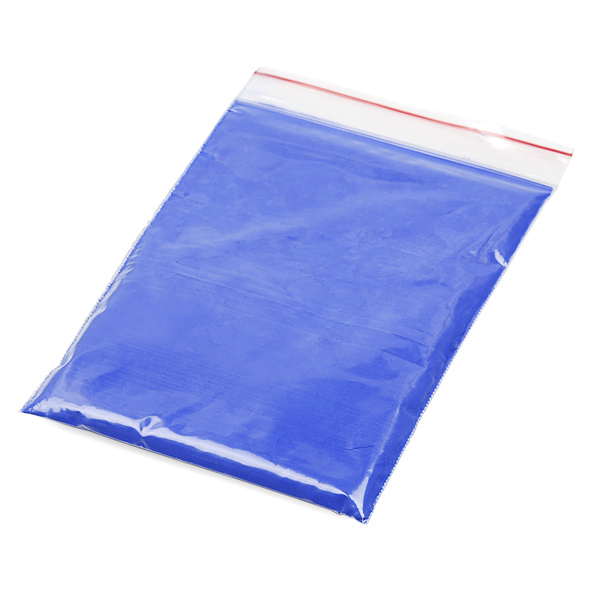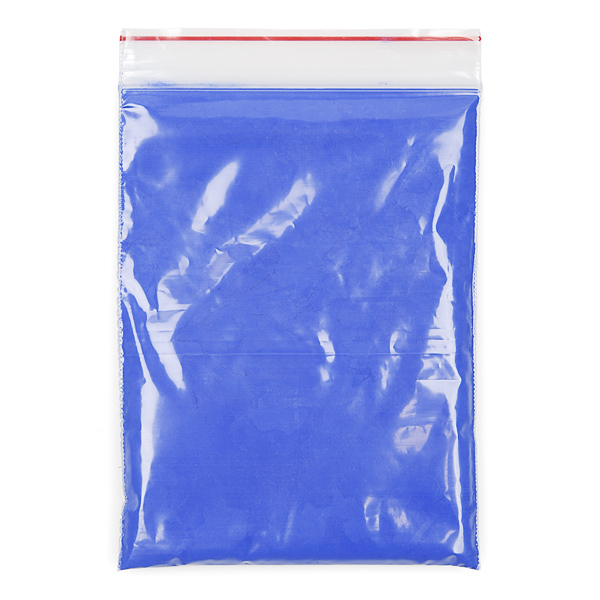Thermochromatic Pigment - Sapphire Blue (20g)
We've all seen toys and things that change color when you run them under warm water or heat them up in the sun. Some of us were especially mesmerized and had to find out what made them do that. It turns out that this is a property called "thermochromism" and it can be implemented in a number of ways. This particular pigment is a Leuco dye type pigment which is made up of a mixture of Leuco dyes, weak acids and salts microencapsulated in polymer. Sounds complicated, right? Nah, it's not so bad.
All you need to know is that this is a very fine, colored powder that changes to a clear powder when you heat it to about 92°F (33°C). This is really cool for a lot of reasons. You can mix this pigment with paint to create thermochromatic paint for craft projects or to make temperature indicators. It mixes with Sugru and Polymorph as well, rendering them both thermochromatic. Use a controllable electric heating source and you could even build a thermochromatic display!
This pigment comes in a 20g bag, which is more than enough to play with and just enough for a good sized project (depending on what you're doing with it). Careful not to overheat the pigment as temperatures over 200°C can cause irreversible damage to most Leuco dyes.
- Blue at Room Temperature
- Turns Clear at Around 92°F (33°C)
- Mix with paint, glue, resin, Polymorph, Sugru, etc.
Thermochromatic Pigment - Sapphire Blue (20g) Product Help and Resources
21st Century Fashion Kit: Electrochromatic Circuits
November 5, 2014
Diana Eng walks you through a magically appearing design made with an thermochromatic pigment.
Electronic E-craft Terrarium
January 21, 2016
A guest tutorial on an Electronic Terrarium from the Performative Sculpture class of Parsons DT.
Core Skill: DIY
Whether it's for assembling a kit, hacking an enclosure, or creating your own parts; the DIY skill is all about knowing how to use tools and the techniques associated with them.
Skill Level: Noob - Basic assembly is required. You may need to provide your own basic tools like a screwdriver, hammer or scissors. Power tools or custom parts are not required. Instructions will be included and easy to follow. Sewing may be required, but only with included patterns.
See all skill levels
Comments
Looking for answers to technical questions?
We welcome your comments and suggestions below. However, if you are looking for solutions to technical questions please see our Technical Assistance page.
Customer Reviews
No reviews yet.



-------------------- Tech Support Tips/Troubleshooting/Common Issues --------------------
Look here for more tips on using thermochromatic pigment => [ https://www.sparkfun.com/products/11555#comment-58ec012ef3b1a81f3a8b4567 ].
Is it safe to use on some jewelry? Is it toxic?
Is there a pigment to paint ratio roughly?
use of thermochromic pigments in a brazilian project: http://www.youtube.com/watch?v=7eAfuHPX6nw
Would it be possible to use this to tie-dye a bed sheet?
Be careful with sunlight. It is not suitable to outdoor usage but only indoor as it doesn't have UV protection. The organic components that are utilized in the pigments gets old with UVs. Do not expose above 75ºC for long periods. Expose until 200ºC only for time peaks. Although it has some cares to be taken, the potential applications have a huge range.
so if i repaint my car, i'll know when the seat is goinna burn getting in :D very cool product, though my other thought is back to the 2007 hot wheels color changing cars. did they work on the same principle? too warm, they go clear to reveal the color underneath? or is there a version that also changes from one color to another?
Kamiquasi is right! You can use these pigments to make something that changes color by combining with other pigments, mixing with a transparent binder and painting over another color, or blending with a material that is already another color (like sugru). It can take a lot of pigment to really achieve a color change in another product, but I've had really good luck rolling, pressing, or dusting pigment onto sticky surfaces rather than trying to mix through. This has worked fairly well with polymorph, sugru, and acrylic paint, and really reduced the amount of pigment needed for a dramatic color change.
If you were to paint your car - don't expect it to last. They're not UV-stable. You'll want to at least add a UV-filter coat but that will only lengthen its life, not make it permanent :)
There are a few that change between 2 colors but they are based on much the same principle - 1 dye as a base color and the other dye actually going between a color and relative transparency.
One neat thing though is that you can actually have a bit of control over the temperature at which these changes happen. So if you have multiple colors at different temperatures, you can get a nice change between several colors.
Unfortunately, there aren't many places to source these properly. Chemistry shops can sometimes deliver, but can also be quite expensive. One source for a Leuco dye-based solution that has a visual impact similar to liquid crystal thermochromics (think of 'paper' thermometers) is StardustColors in France. Look for "PULSAR" for the multicolor solution (they also offer basic colors).